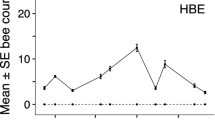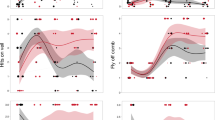Summary
The Bell Miner (Manorina melanophrys, Meliphagidae) is a medium-sized, colonial and co-operatively breeding honeyeater. Recent works show that the Bell Miner presents clear patterns of interspecific competition involving aggressive behaviour against many honeyeaters (Meliphagidae) and other bird species (Loyn et al. 1983; Clarke 1984). Nevertheless, those works have been based on short-term (1 year or less) studies only, and none of them have studied the effect territorial defence has on Bell Miners' fitness. We show how the population of honeyeaters decreased over 7 years at the Sir Colin Mackenzie Zoological Park (Southeastern Victoria, Australia). The decrease of honeyeaters in the study site was correlated with a local increase in the Bell Miner population which has been expanding since at least 1983. This process presumably led to the spatial zonation of Bell Miners and honeyeaters observed at present, while other passerine species show no sensitivity to either the invasion of Bell Miners in the recent past or to the present spatial distribution of the Bell Miner population. Finally, we show that Bell Miner reproductive activity is not affected by their interaction with competitors, which leads us to conclude that the interaction between the Bell Miner and other honeyeaters would be better described as asymmetrical competition.
Similar content being viewed by others
References
Abrams PA (1987) On classifying interactions between populations. Oecologia 73: 272–281
Blakers M, Davies SJJF, Reilly PN (1984) The atlas of Australian birds. Melbourne Univ. Press, Melbourne
Brown JL (1987) Helping and communal breeding in birds. Ecology and evolution. Princeton Univ. Press, Princeton
Clark KL, Robertson RJ (1979) Spatial and temporal multi-species nesting aggregations in birds as anti-parasite and anti-predator defenses. Behav Ecol Sociobiol 5: 359–371
Clarke MF (1984) Interspecific aggression within the Genus Manorina. Emu 84: 113–115
Clarke MF (1988) The reproductive behaviour of the Bell Miner Manorina melanophrys. Emu 88: 88–100
Connell JH (1983) On the prevalence and relative importance of interspecific competition: evidence from field experiments. Am Nat 122: 661–696
Connor EF, Simberloff D (1979) The assembly of species communities: chance or competition? Ecology 60: 1132–1140
Conover WJ (1980) Practical nonparametric statistics. Second ed. John Wiley and Sons, Inc. New York
Diamond JM (1978) On competition and variable environments. Am Scient 66: 322–331
Dow DD (1977) Indiscriminate interspecific aggression leading to almost sole accupancy of space by a single species of bird. Emu 77: 115–121
Dow DD (1978) Breeding biology and development of the young of Manorina melanocephala, a communally breeding honeyeater. Emu 1978: 207–222
Gentilli J (1971) (ed) Climates of Australia and New Zealand. Elsevier Publ. Co., Amsterdam
Gotmark F, Andersson M (1984) Colonial breeding reduces nest predation in the Common Gull (Larus canus). Anim Behav 32: 485–492
Hilborn R, Stearns SC (1982) On inference in ecology and evolutionary biology: the problem of multiple causes. Acta Biotheoretica 31: 145–164
Lawton JH, Hassell MP (1981) Asymmetrical competition in insects. Nature 289: 793–795
Loyn RH, Runnals RG, Forward GY, Tyers J (1983) Territorial Bell Miners and other birds affecting populations of insect prey. Science 221: 1411–1413
Ovington JD, Pryor LD (1983) Temperate broad-leaved evergreen forests of Australia. In Ovington JD (ed) Ecosystems of the world 10. Temperate broad-leaved evergreen forests. Elsevier, Amsterdam pp 73–101
Pulliam HR (1983) Ecological community theory and the coexistence of sparrows. Ecology 64: 45–52
Quinn JF, Dunham AE (1983) On hypothesis testing in ecology and evolution. Am Nat 122: 602–617
Rabenold KN (1984) Cooperative enhancement of reproductive success in tropical wren societies. Ecology 65: 871–885
Reynolds JC (1985) Details of the geographic replacement of the red squirrel (Sciurus vulgaris) by the grey squirrel (Sciurus carolinensis) in Eastern England. J Anim Ecol 54: 149–162
Ricklefs RE (1979) Ecology. Second ed. Chiron Press New York
Robinson SK (1986) The evolution of social behavior and mating systems in the blackbirds (Icterinae). In: Rubenstein DI and Wrangham RW (eds) Ecological aspects of social evolution. Birds and Mammals. Princeton University Press pp 175–216
Roughgarden J (1983) Competition and theory in community ecology. Am Nat 122: 583–601
Schoener TW (1983) Field experiments and interspecific competition. Am Nat 122: 240–285
Schoener TW (1988) Ecological interactions. In: Myers AA and Giller PS (eds) Analytical Biogeography. Chapman and Hall, London: pp 255–297
Siegel S (1956) Nonparametric statistics for the behavioral sciences. McGraw-Hill Kogakusha Ltd., Tokyo
Smith AJ, Robertson BI (1978) Social organization of Bell Miners. Emu 78: 169–178
Sokal RR, Rohlf FJ (1981) Biometry. Second ed. WH Freeman and Co. San Francisco
Specht RL, Roe ME, Boughton VH (1974) Conservation of major plant communities in Australia and Papua New Guinea. Aust J Bot, Supl. 7: 667
Strong DRJr (1983) Natural variability and the manifold mechanisms of ecological communities. Am Nat 122: 636–660
Wiens JA (1977) On competition and variable environments. Am Scient 65: 590–597
Woinarski JCZ, Wykes BJ (1983) Decline and extinction of the helmeted honeyeater at Cardinia creek. Biol Conserv 27: 7–21
Wykes BJ (1985) The Helmeted Honeyeater and related honeyeaters of Victorian woodlands. In: Keast A, Recher HF, Ford H, Saunders D (eds). Birds of eucalypt forests and woodlands: ecology, conservation, management. Surrey Beatty and Sons Pty Ltd and R.A.O.U. NSW: 205–217
Zack S, Ligon JD (1985) Cooperative breeding in Lanius shrikes. I Habitat and demography of two sympatric species. Auk 102: 754–765
Author information
Authors and Affiliations
Rights and permissions
About this article
Cite this article
Poiani, A., Rogers, A., Rogers, K. et al. Asymmetrical competition between the bell miner (Manorina melanophrys, Meliphagidae) and other honeyeaters: evidence from Southeastern Victoria, Australia. Oecologia 85, 250–256 (1990). https://doi.org/10.1007/BF00319410
Received:
Accepted:
Issue Date:
DOI: https://doi.org/10.1007/BF00319410




